Cricket Lighting: Led Light for Cricket Ground
Cricket Lighting: Led Light for Cricket Ground
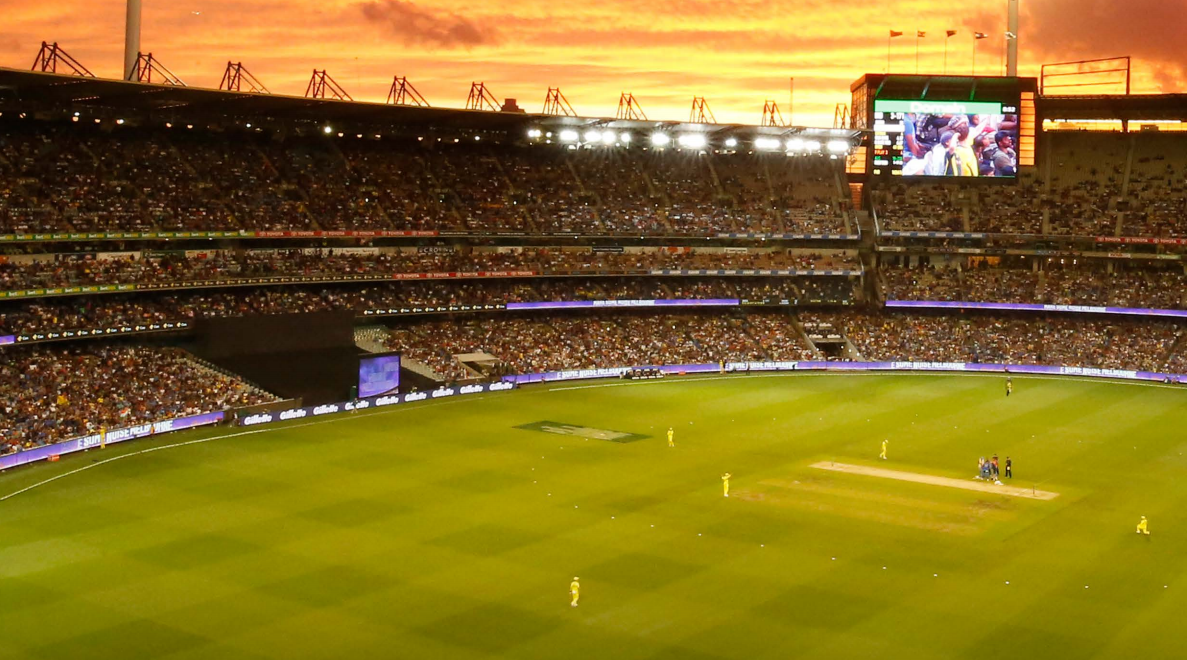
Directory:
1. Introduction:
2. Recommended Cricket Lighting Levels
3. Planning & Design
4. Transitioning Lighting Installations To Led
5. Led Light for Cricket Ground
1. Introduction:
The way cricket is being played and consumed continues to evolve.The rise of short-form cricket(in particular T20 competitions)and the emergence of new modified programs and activities means cricket is now being played by more participants,more frequently,at more venues(including indoors)and by a wider,more diverse playing group than ever before.
Whilst it is important that we don't lose sight of the game's traditional format and related infrastructure requirements,the provision of facilities that accommodate cricket's expanding suite of competition,training and program offerings is crucial if the sport is to continue to grow,and more importantly,capitalise on a societal trend towards more flexible sport/leisure opportunities and associated scheduling.
The term 'Lighting up Cricket' features heavily in several recently developed state infrastructure strategies,particularly those states located in the country's north,where no daylight savings and/or climatic conditions mean playing and training in the evening under lights is often the more preferable,or in some instances,the only opportunity for cricket to be played.In land-locked municipalities,where access to unoccupied open green space is challenging,facility owners and managers are looking for innovative ways to increase the carrying capacity of their existing venues.Floodlighting of sports fields and supporting training facilities provides one solution to increase programming beyond standard daylight hours.
Access to more lit venues will undoubtedly enable greater programming flexibility for cricket.However,of equal importance is that both the lighting design and level of lighting(lux)provided ensure a safe and suitable environment for players,coaches,officials and spectators alike.An increase in power hitting(during both training and competition activities)is a significant shift in how the game is being played,both indoor and outdoors.For example,a faster,more dynamic game is taking place within the infield,while high balls into the outfield are becoming more frequent as batters seek to score more quickly as a result of limited overs.For this reason,the provision of safe and suitable lighting is critical.
2. Recommended Cricket Lighting Levels
The tables on the following pages outline the recommended minimum lighting levels for cricket training and competition(outdoor and indoor).
2.1 Outdoor Cricket
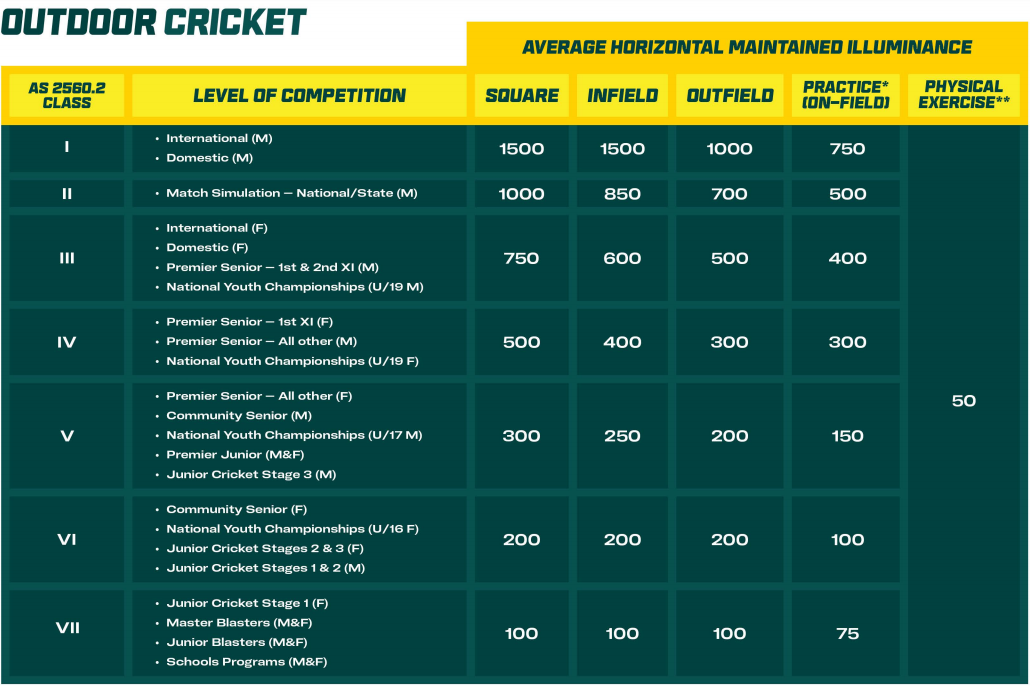
Notes: Lighting levels relate to non-broadcast outdoor cricket competition.
Lighting levels provided are based on use of a standard white ball,however are also considered appropriate for a pink ball.
The use of sight screens that contrast with the ball colour is important to enable quick and clear visual identification.
2.2 Cricket Training Outdoors
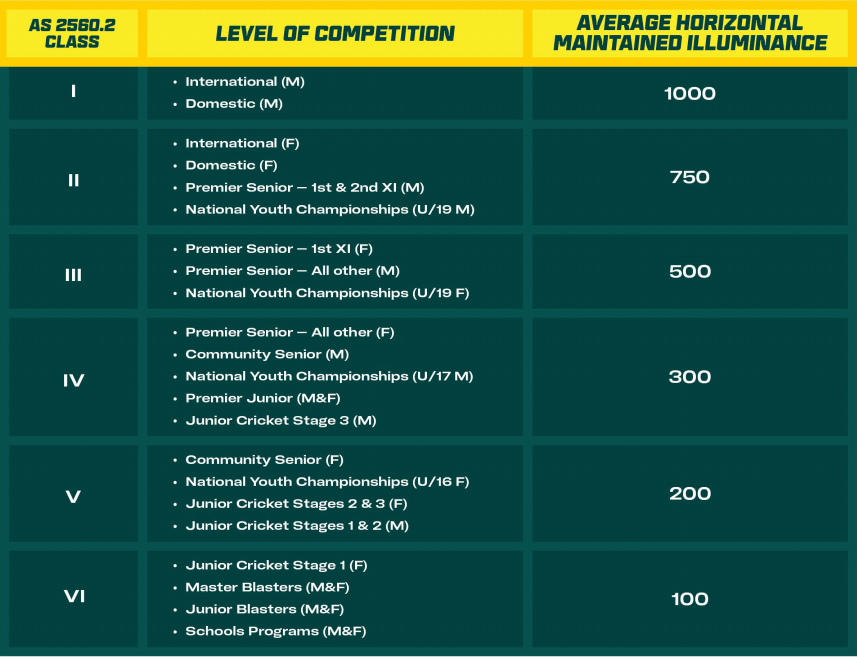
Note: Lighting levels provided are based on use of a standard white ball,however are also considered appropriate for a pink ball.
2.3 Cricket Training Indoors
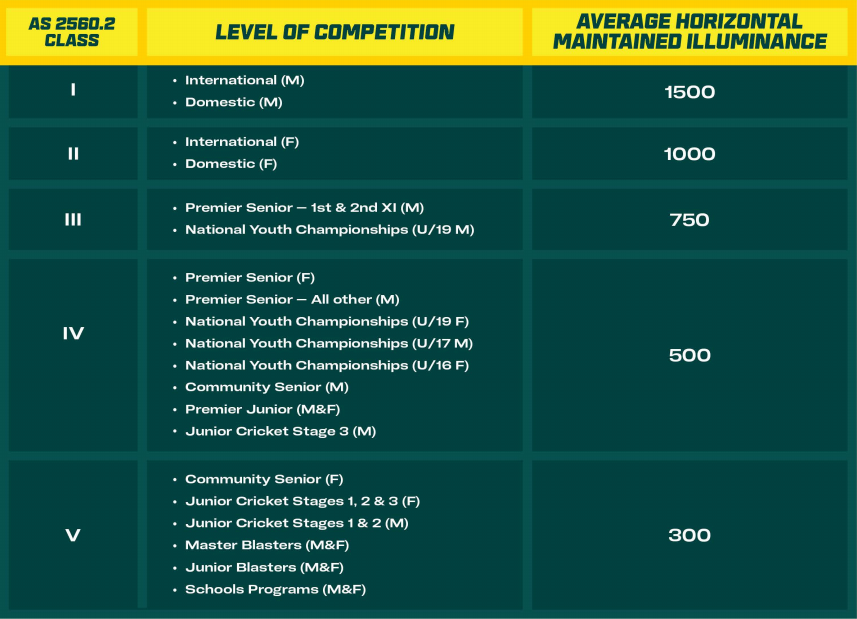
Note: Lighting levels provided are based on use of a standard white ball, however are also considered appropriate for a pink ball.
2.4 Indoor Cricket
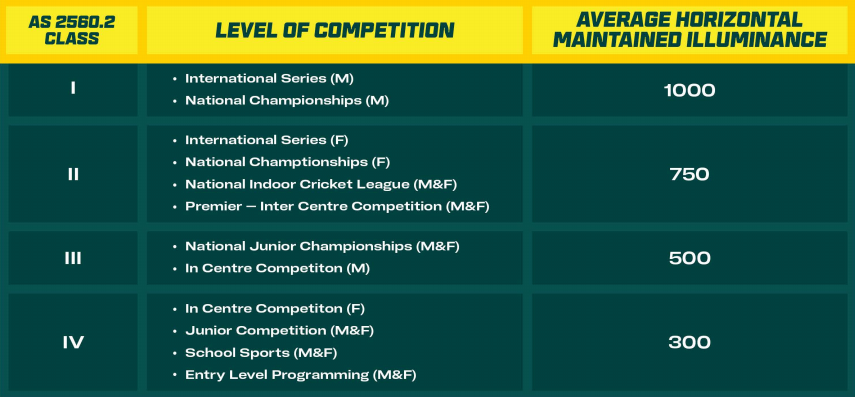
Note:Lighting levels are based on use of a standard yellow indoor cricket ball.
3. Planning & Design
New Installation Lighting Design
3.1 Cricket Lighting Design Process
(1) All cricket lighting should be designed by a qualified lighting and electrical engineer.
(2) Some detailed information is required before the engineer can proceed with their design works.They will generally require the following for a new outdoor installation:
A feature survey and/or civil detailed design drawings to overlay the lighting design on.This will ensure you achieve the most accurate design outcomes.
Information regarding the existing site including the power installation.
(3) Consider and consult with likely co-tenant sporting codes(football,allcodes) with a view to reducing/sharing infrastructure costs,mutual lighting compliance and other shared efficiencies.
3.2 Average Horizontal Maintained lluminance
(1) The illuminance values in the tables are what is termed average horizontal maintained lluminance, being the value below at which the averageilluminance level on the field of play is not allowed to fall.
(2) For new projects,the average illuminance will need to be higher than the maintained value considering light loss over time due to the environment and scheduled maintenance periods.
(3) It is recommended the lighting design use and justify a depreciation factor,known as 'Light Loss Factor',accounting for luminaire lumen depreciation and luminaire dirt depreciation applicable to the site.
It is recommended lighting testing be conducted at the beginning of each season to ensure the average horizontal maintained illuminance remains in line with recommended lighting levels.
Being exposed to the elements,it is common for lamps or luminaires on floodlights to accumulate dirt/dust or be subject to movement as a result of high winds.
Uncleaned and/or misdirected lighting can significantly impact on average horizontal maintained illuminance levels.
3.3 Pole Configuration and Heights
(1) In an outdoor situation,the lighting towers should ideally be located so that they do not line up with the cricket pitch.
(2) The height of the poles is determined by the size of the ground.Under the standard,Class l and Il venues require poles with a minimum height of 40 metres,while poles at Class II-VIl venues should be 30 metres in height.
3.4 Player Glare
(1) Glare can occur when the placement of the lamp is in the line of sight of the ball in player's main view directions.The positioning and height of the light towers will affect the amount of glare present.
(2) A maximum glare rating GRmax=50 is permitted.
3.5 Obtrusive Light
(1) All external lighting designs are required to meet the requirements off AS/NZS 4282:2019 Control of the obtrusive effects of outdoor lighting.
(2) Conformance to this standard shall be demonstrated by the results of calculations and analysis of design methods with respect to the standard.This should be provided with the lighting design and is normally a requirement for the granting of a development or building permit.
(3) The standard sets illuminance and intensity limits in environmentally relevant vertical planes depending on ambient lighting conditions.It also sets limits for limiting glare to transport systems/road users and upward waste light directed into the night sky.
(4) The design should conform to the environmental zone which varies as to the usage and location of the space.For example:suburban areas in towns and cities are rated as category A3 with equates to 10 lux verticalilluminance and maximum luminous intensity per luminaire of 12500 cd at windows.
3.6 Civil and Structural Works
(1) The foundation design of the same pole and floodlight system willdiffer between sites due to differing soil conditions.
(2) The number and type of light fittings per tower(wind sail area and weight),the site's wind rating and the site's soil type and wind rating can affect the depth and outside diameter of the concrete footing required.
(3) The Geotech report should be taken at the pole positions and be at a depth of 6m.
3.7 Building Permit
Pending the height of new lighting poles or structures,it is recommended you consult with your relevant Building Authority to confirm if a building permit is required.
3.8 Lighting in the vicinity of an Airport
If your venue is within a 6km radius of an airport,the relevant authority should be contacted to determine whether any particular restrictions apply.
4. Transitioning Lighting Installations To Led
Many lighting installations are presently being upgraded to LED.
Replacing an installation with LED luminaires is desired due to the advantages of:
(1) Instant operation
(2) Energy savings,in the order of 50%
(3) Low maintenance:regular lamp replacement not required(note that if the LED(s)fail,a replacement of the whole luminaire may be required)
(4) Ability to provide improved lighting control allowing excellent lighting
uniformity and less spill to neighbouring properties
(5)Option to dim (note:not all luminaires can be dimmed.This will depend on the driver technology choice)
Indoor installations,whether metal halide or fluorescent installations can be replaced with LED alternatives usually in the same position taking advantage of the existing wiring.
There are many LED luminaires available with different qualities,durability and lighting distributions.A good design will ensure that an appropriate solution is chosen,while a poor choice will result in high levels of player glare,poor uniformity and shortened lifespan.
A one for one replacement of pole mounted metal halide luminaires can provide higher levels ofilluminance with lower energy use.It is important to choose luminaires with low windage so as to not overload the pole.If there is building permit information of theinstallation,the designer will be able to calculate the maximum number of floodlights of a certain type that can be installed.
An upgrade to an existing installation should meet all the factors of a new installation.
If upgrading an existing lighting installation,being able to provide a copy of the'as-built'drawings to your electrical lighting engineer will assist with the design process.
If you are looking to retain existing light poles as part of ametal halide to LED lighting transition, consult with an electrical engineer first to certify pole suitability.
5. Led Light for Cricket Ground
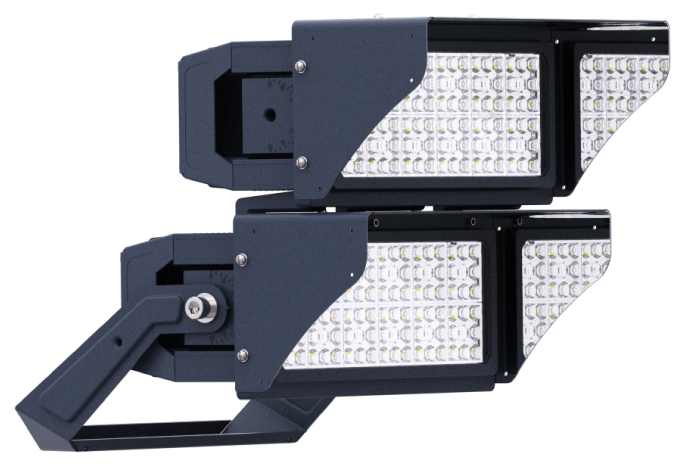
_thumb.jpg)